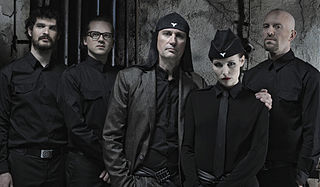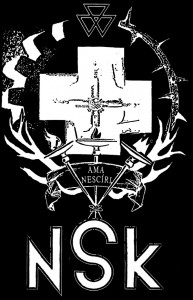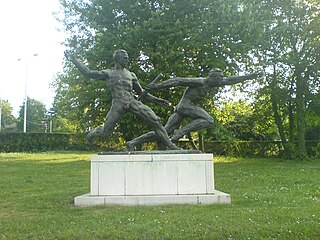
Laibach is a Slovenian and Yugoslav avant-garde music group associated with the industrial, martial, and neo-classical genres. Formed in 1980 in the mining town of Trbovlje, Slovenia, at the time a constituent republic within Socialist Federal Republic of Yugoslavia, Laibach represents the musical wing of the Neue Slowenische Kunst (NSK) art collective, a group which Laibach co-founded in 1984.

Neue Slowenische Kunst is a political art collective that formed in Slovenia in 1984, when the Socialist Republic of Slovenia was part of Socialist Federal Republic of Yugoslavia. NSK's name was chosen to reflect the theme in its works of the complicated relationship Slovenes have had with Germans. The name of NSK's music wing, Laibach, is also the German name of the Slovene capital Ljubljana. The name created controversy because some felt it evoked memories of the Nazi annexation of Slovenia during the Second World War. It also refers to Slovenia's previous seven centuries as part of the Habsburg monarchy.
In the minds of many foreigners, Slovenian folk music means a form of polka that is still popular today, especially among expatriates and their descendants. However, there are many styles of Slovenian folk music beyond polka and waltz. Kolo, lender, štajeriš, mafrine and šaltin are a few of the traditional music styles and dances.
IRWIN is a collective of Slovenian artists, primarily painters, and an original founding member of Neue Slowenische Kunst (NSK).
New wave in Yugoslavia was the new wave music scene of the Socialist Federal Republic of Yugoslavia. As its counterparts, the British and the American new wave, from which the main influences came, the Yugoslav scene was also closely related to punk rock, ska, reggae, 2 tone, power pop and mod revival. Some of its acts are also counted as belonging to the Yugoslav punk scene which already existed prior to new wave. Such artists were labeled as both punk rock and new wave.

Michael Benson is an American author, artist, filmmaker, and exhibitions producer whose most recent work centers on the convergence of art and science. In the last fifteen years Benson has produced a series of large-scale exhibitions of digitally constructed planetary landscapes in major international museums. His most recent book, Space Odyssey, is a detailed nonfiction examination of the production of Stanley Kubrick's 2001: A Space Odyssey. The book's publication was timed to coicide with the 50th anniversary of the film's theatrical release. Benson has written for The New York Times, The Washington Post, The New Yorker, The Atlantic, and Rolling Stone. He is currently using scanning electron microscope technologies at the Canadian Museum of Nature in Ottawa to view and photograph natural objects for a book and exhibition project titled Nanocosmos. He is a Fellow of the New York Institute of the Humanities, a Weizmann Institute Advocate for Curiosity, and was recently a Visiting Scholar at the Center for Bits and Atoms at the MIT Media Lab.
Daniel Landin BSC, is a British cinematographer, and a member of the British Society of Cinematographers.

Volk is the seventh studio album by Slovenian industrial group Laibach, released in 2006. The word "volk" means "people" or "nation" in German and "wolf" in Slovene. The album is a collection of thirteen songs inspired by national or pan-national anthems, plus the anthem of the Neue Slowenische Kunst (NSK) State, a fictional state invented by the band. The album is a collaboration with another Slovenian band, Silence.
Popular music in Yugoslavia includes the pop and rock music of the former SFR Yugoslavia, including all their genres and subgenres. The scene included the constituent republics: SR Slovenia, SR Croatia, SR Bosnia and Herzegovina, SR Montenegro, SR Macedonia and SR Serbia and its subunits: SAP Vojvodina and SAP Kosovo. The pop and rock scene was a part of the general Music of Yugoslavia, which also included folk, classical music, jazz etc. Within Yugoslavia and internationally, the phrases ex-YU or ex-Yugoslav Pop and Rock both formally and informally generally to the SFRY period, though in some cases also to its successor the FR Yugoslavia including Serbia and Montenegro which existed until 2006.

The Relay of Youth was a symbolic relay race held in Socialist Federal Republic of Yugoslavia every year. The relay carried a baton with a birthday pledge to Josip Broz Tito ostensibly from all young people of Yugoslavia. The race usually started in Tito's birth town Kumrovec and went through all major towns and cities of the country. It ended in Belgrade at JNA Stadium on May 25, Tito's official birthday and Day of Youth, a national holiday.
Mladina is a Slovenian weekly left-wing political and current affairs magazine. Since the 1920s, when it was first published, it has become a voice of protest against those in power. Today, Mladina's weekly issues are distributed throughout the country. Mladina is considered one of the most influential political magazines in Slovenia.
Igor Vidmar is a prominent Slovenian and former Yugoslav journalist, rock music promoter and manager, music producer and political activist.
Inke Arns is a German curator and theorist known for her works focusing on media arts.
Charles Wing Krafft was an American painter and ceramicist whose later work incorporated traditional ceramic decorative styles to produce works commemorating modern disasters. In 1998, he was called "the dark angel of Seattle art" by the art critic of the Seattle Post-Intelligencer. In early 2013 it was revealed that he participated in white nationalist and Holocaust denial websites, which led to a re-evaluation of his artwork.

Zdenka Badovinac is a curator and writer, was the director of the Museum of Contemporary Art Zagreb, Croatia. She served between 1993 and 2021 as director of the Museum of Modern Art in Ljubljana, comprised since 2011 of two locations: the Museum of Modern Art and the Metelkova Museum of Contemporary Art in Metelkova, an autonomous art, culture, and social center in Ljubljana. In 2022, she was appointed director of the Museum of Contemporary Art in Zagreb. She resigned from her position in the fall of 2023 for personal reasons. She returned to Ljubljana, where she currently works as an independent curator, author and international consultant.
Subversive affirmation is an artistic performance that overemphasizes prevailing ideologies and thereby calls them into question. Simultaneously with affirmation, the affirmed concepts are revealed, and artists distance themselves from those concepts. Strategies of subversive affirmation include "over-identification", "over-affirmation" and "yes revolution".

Europe Today is a theatre show produced in cooperation between East West Theatre Company and Slovene National Theatre. The show is based on an essay written by Miroslav Krleza and directed by Haris Pasovic. Production also included Miki Manojlovic, an actor; Edward Clug, a contemporary dancer and choreographer; as well as the industrial, neoclassical band Laibach. The dramaturgy of the production was done by Dubravka Vrgoc, director of Zagreb Youth Theatre. The artists, who reside in Slovenia, Serbia, Bosnia and Herzegovina and Croatia, rehearsed in Maribor's Slovene National Theatre during February 2011. The show opened February 16 and it provoked great regional and international interest.
The Scipion Nasice Sisters Theatre was founded on 13 October 1983 in Ljubljana by Eda Čufer, Dragan Živadinov and Miran Mohar, three Slovenian students.

Škuc Gallery, part of Slovenia's Student Cultural Centre (ŠKUC), is a contemporary art gallery located on Stari trg 21 in Ljubljana, Slovenia. Established in 1978, it operates as a central venue for artistic and social initiatives, including visual arts, music, and publishing. The gallery's focus is on contemporary art and social issues and engagement.








